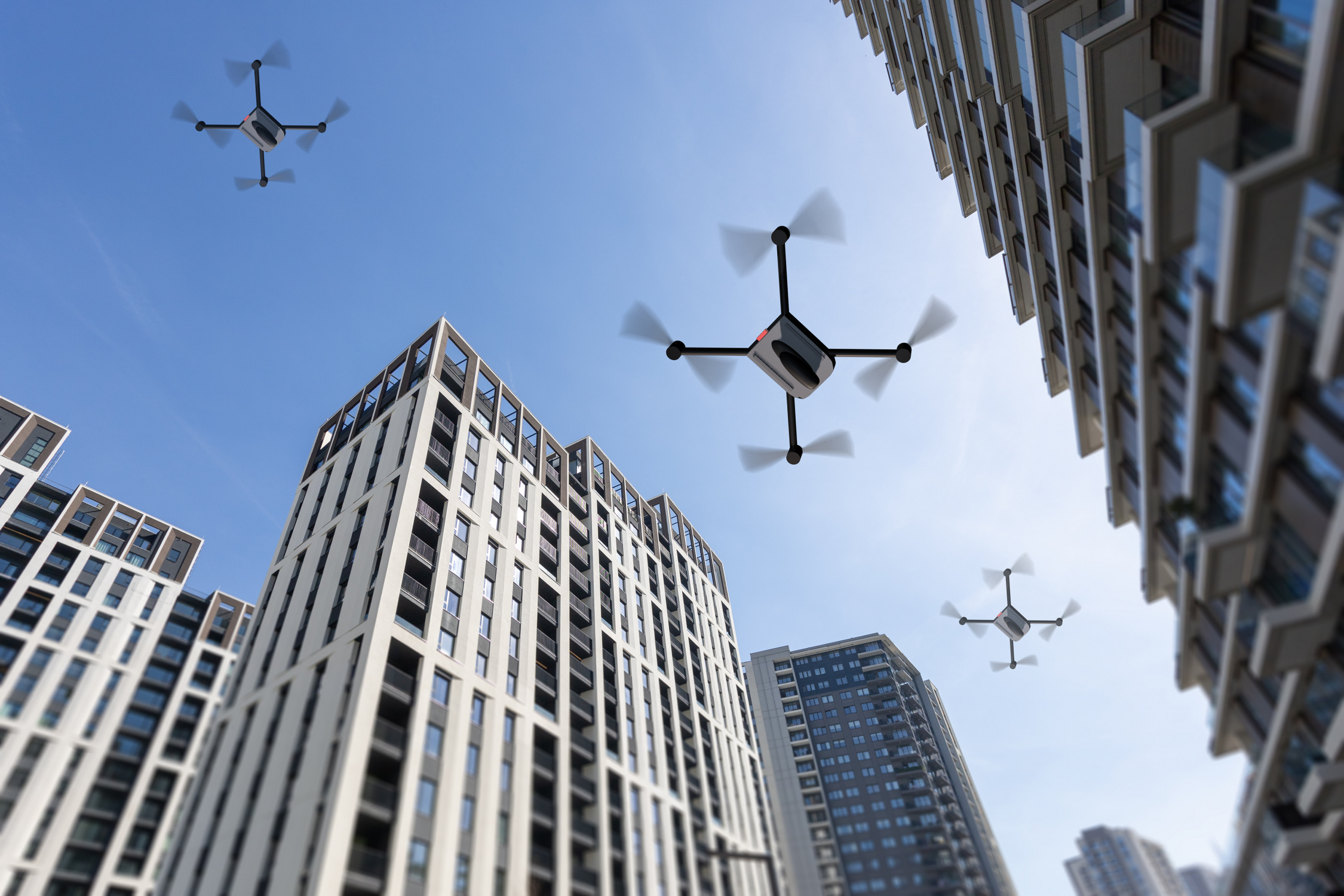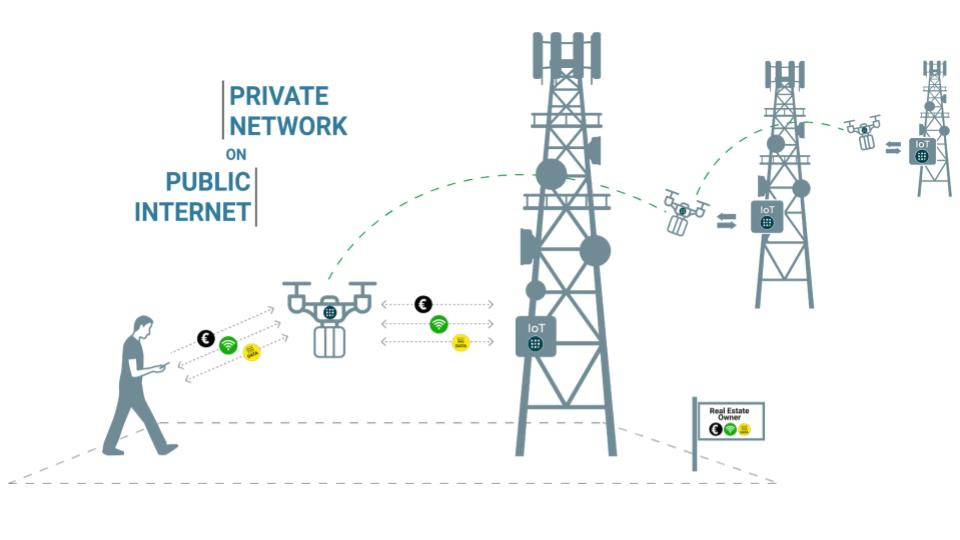Dr. Alexandra Mikityuk imagines a future where drones will use dedicated open air around us. They’ll swoosh around our heads and deliver blood for medical purposes, or pizza for the late shift worker in a remote factory. You know, the one who’s monitoring the robots.
IoT (Internet of Things) is entering every area of our lives. The possibilities are infinite for machines that communicate via the internet with each other and their operators. But with the fleets of autonomous vehicles growing and the scope of their tasks increasing, operating them becomes more complex, risky, and potentially dangerous.
Dr. Alexandra Mikityuk and her team have taken on the challenge of simplifying and securing IoT connectivity. Her solution, called Staex, involves Web3 and blockchain technology.
Update: in spring 2024 they established the first ever Web3 drone corridor. More on that in the article.

Image source: iStock, credit aerogondo
Why blockchain and IoT need to team up
Most of us think of home appliances when we hear about IoT. Drones are little more than a fancy gadget. But industrial robots that operate in the thousands in factories are already real. And so are commercial drones in surveillance, homeland security, and agriculture. All these are part of the Internet of Things.
To understand why blockchain and IoT should be connected, you first need to understand the unique challenges the devices are facing.
What are the key challenges in operating IoT devices today?
- Security
Today, connectivity to the internet is typically facilitated by network routers, which are a popular target for hackers. This makes IoT devices vulnerable to a variety of malicious attacks, including ransomware. “Today, devices have around 5,400 attacks per month. This is talking about them being on the Internet”, says Dr. Mikityuk.
- Cost
Besides high vulnerability in the communication area, robots and drones operators face increasing costs. The cloud application frequently pings the device to keep the communication alive and that costs money. Cloud hosting, application management, and manual updates are expensive. On top of that, when you experience a security breach, the financial loss can be enormous.
- Identification
In many scenarios, manufacturers operating IoT devices have a hard time identifying individual devices. Their robots are moving in large spaces using network roaming and dynamic IP addresses. Keeping track of which robot is where and recognizing each one is close to impossible.
- Updates
Much of the updating is still carried out manually. This is time-consuming and leaves a lot of room for errors. In turn, it also drives up costs.
Automatic updates are often interrupted because of Wi-Fi roaming, which leads to errors and loss of operation time.
How does Web3 security work for IoT?
Using a distributed infrastructure eliminates many vulnerabilities in the communication. In the current setup, a hacker can bring an entire organization to its knees by hacking into a single device. In a Web3 setup, when a single node is compromised, the network isn’t affected. Accessing information is practically impossible. Dr. Mikityuk explains how blockchain’s distributed setup offers a solution.
“Every machine has its own key and it knows the key of the machine that it is sending information to. So first and foremost, the communication between machines is always secured.” Without a key to the other machine, there’s no access.
Only the manufacturer has the digital key that allows communication with the autonomous vehicles out there. Communication is only possible with this specific key. Instead of needing to secure countless routers and internet connections, you only need to keep the one key safe.
How can Web3 reduce costs and address the IoT challenges?
- With Staex’s Web3-based solution, constant pinging is unnecessary. You pay a fixed monthly price based on your subscription package. This allows for much more clarity and control of cost management than with cloud-based services.
- Each device receives a unique identifier. Operators never have to guess and can easily monitor, track, and perform maintenance on specific machines. The information that the device provides, or needs to communicate, can only be accessed with a unique key connected to the identifier. Autonomous vehicles become almost impossible to hack and a lot easier to maintain.
- Updates are performed autonomously when the system requires it, not manually. There’s no need to pause the machine’s operation or carry out any manual operation. Interruptions are no longer a problem, because there aren’t any. In a distributed network setup, there’s practically zero downtime.
How exactly does Staex use blockchain for IoT connectivity improvement?
Staex is a protocol on top of mobile communication that isolates machines. The most prominent use case today is remote access for the manufacturers themselves. The manufacturer’s machine talks to the fleet of machines — which can be as large as two million — so it acts as a type of VPN. Only, it’s cheaper and more secure.

Image source: Staex
In the words of Dr. Mikityuk, “It’s basically a network layer with an application management. It’s a beautiful combination of things which, in this form, were hard to combine in the previous Internet”.
Another aspect of using blockchain for IoT is that there’s no middleman operating the system. Staex doesn’t host anything. It’s not a cloud-based solution, but a distributed Web3 platform.
Is Staex unique in creating IoT blockchain projects?
“Blockchains are amazing technologies and there are many great teams working on a variety of protocols. But you can’t easily connect most of it to existing legacy systems.”
Staex’s solution breaks out of the Web3 bubble. “This is an interesting project that connects older assets to the Web3 economy. So it’s not all shiny NFTs. It’s a very grounded, applied business use case. For instance, Staex offers customers the possibility to use only their own machines with no need for using cloud services, etc.”
“Staex helps IoT manufacturers manage simple edge applications like protocol translation or blockchain payments for their machines. This is what Staex is doing with the RISE project, helping companies use Web3 technologies to add new revenue streams to their existing assets, making it a compelling business case.”

Image source: Staex
Connecting the machines and devices of multi-party stakeholders
Staex has spearheaded a public-private partnership among corporations and Web3 entities, focusing on connecting the machines and devices of multiple stakeholders. This concept of a technologically advanced infrastructure raises the question: how does Staex contribute to building a Web3-based machine infrastructure in practice?
How does Staex contribute to building a Web3-based machine infrastructure?
Staex led a consortium of nine partners in an initiative centered around Vantage Towers AG the operator of over 84,000 telco towers across Europe. Utility companies like Vantage Towers face increasing costs in maintaining and operating their physical assets. The consortium aimed to explore the potential of creating drone highways or corridors between these towers.
Dr. Mikityuk, explains, “Today we have highways for cars, and that’s a very structured approach. So we are creating the same for drones.” The innovative approach leverages existing infrastructure—telco towers—to facilitate this new mode of transport.
Beyond cost-savings
The project involves setting up drone take-off and landing stations at strategic locations to create commercial flight routes for drones.
These drones can be used for data capturing and delivery, significantly reducing costs for asset monitoring and intelligence gathering. For Vantage Towers, this means substantial savings and potential business benefits.
First Web3 drone corridor
The vision materialized with the creation of the first drone corridor in Berlin, Germany, on private property in Im Marienpark, using Songbird drones from Germandrones.
While the concept of drones flying, collecting data, and paying landing and charging fees seems straightforward, it actually involves a complex network of multi-stakeholders.
These stakeholders include landowners, permit issuers, infrastructure providers, charging station operators, and electricity suppliers, all of whom must be compensated. Traditional Web2 systems are not equipped to handle such intricate micropayments and interactions efficiently.
Industry use case with applied Web3 tools
Staex advocates the use of blockchain to simplify these processes. Instead of the infrastructure provider negotiating multiple contracts with drone manufacturers and operators, smart contracts can handle these autonomously.
This project connects machines and devices from various partners, bridging IoT and Web2 infrastructure with Web3 technology to enable secure payments via the Lisk blockchain.
The Berlin drone corridor project showcases real-time payment for drone data by individuals, illustrating the practical application of Web3 in industry.

Image source: Staex
The need for Web3
“We are currently partnering with Lisk and other blockchain platforms such as ICP to leverage Web3 technologies for solving real-world problems,” says Alexandra.
The first successful industry project, NEXA, exemplifies this collaboration. Partners include Vantage Towers AG, REWE Group’s subsidiary paymenttools, Berlin Partner, Lisk, Chirp Wireless, ICP, Germandrones, The Drivery, and Marienpark.
Launched during Berlin Blockchain Week in May 2024, the project was recognized as a Lighthouse Project by Berlin Partner and garnered significant attention.
During the demonstration, a Songbird drone filmed the event, and the video was instantly available for purchase online. The authenticity of the video was verified by storing its cryptographic hash on the Lisk blockchain.
This use case demonstrates the real value of Web3 for industries requiring tamper-proof data for regulatory reporting or client services needing trusted geolocation and timestamp information.
What’s next?
Staex’s showcase demonstrates the potential of Web3 in IoT. The next step is to transform this showcase into a viable business model in partnership with stakeholders, making the machine-to-machine economy a reality.
A wake-up call from intelligent machine zombies
Why did you decide to get into IoT in the first place?
“I lost a bit of the nativity of the world when I learned how smart and organized hackers are. This was while I was doing my PhD in Informatics Security at the Technical University of Berlin. Let’s take botnet attacks, for example. Over time, they build up an army of, I call them ‘intelligent machine zombies’—, sensors and whatever IoT out there. And they use all this power to blackmail a bank, an organization, or a city.”
Dr Mikityuk also understood that a common security engineer, working nine-to-five in an IoT device company, can’t be expected to carry the responsibility on their shoulders. Even worse, there’s a lot of profit to be made from such attacks and the incentive is unfortunately not on the side of the good guys.
The volume of the cybercrime business is expected to reach 10 trillion dollars in 2025. Ransomware-as-a-Service is a real business model. Anyone can order and carry out a ransomware attack, even with no programming or developer knowledge.
Dr. Alexandra Mikityuk says she feels fortunate to have collected experience in a variety of verticals, touching on many fields where IoT is used. It involves intelligent machines, machines that have an operating system, and “hackers really love them. Today, it’s mostly networking routers because they have processing power that can easily be reused and misused.”
Web3 for drones and other autonomous vehicles
Few of us are aware of the extent of malicious activity on the internet, especially that targeting OT (operational technology) and IoT networks. There’s a tremendous, constant threat to drones, robots, or other autonomous vehicles. The same goes for critical infrastructures, water supplies and manufacturing facilities, anything that uses OS-based sensors to connect to the internet.
“The kind of a-ha moment for me was when I was working for Deutsche Telekom (DT). The DT has been impacted and also a variety of other telecoms have been suffering severe attacks. The manufacturers of these things [IoT devices], then had to replace them in the field and it’s a huge financial loss for everyone. And It’s really complicated to regain the trust of the customer.”
What made you choose blockchain security for IoT as a solution?
All this happened around the time blockchain was coming up in Berlin. She recalls, “This is when I became familiar with Web3 technology and saw the silver bullet to the solution.” Dr. Mikityuk took advantage of the birthplace of many Web3 tools and learned everything she could about blockchain. To this day, she believes in the distributed network concept and that it can solve many issues arising from or in Web2.
It seems we can expect some exciting solutions from Dr. Alexandra Mikityuk and her Staex team. And we join her in the hope that, “through these secure and reliable systems we can maintain human agency over machines.”




